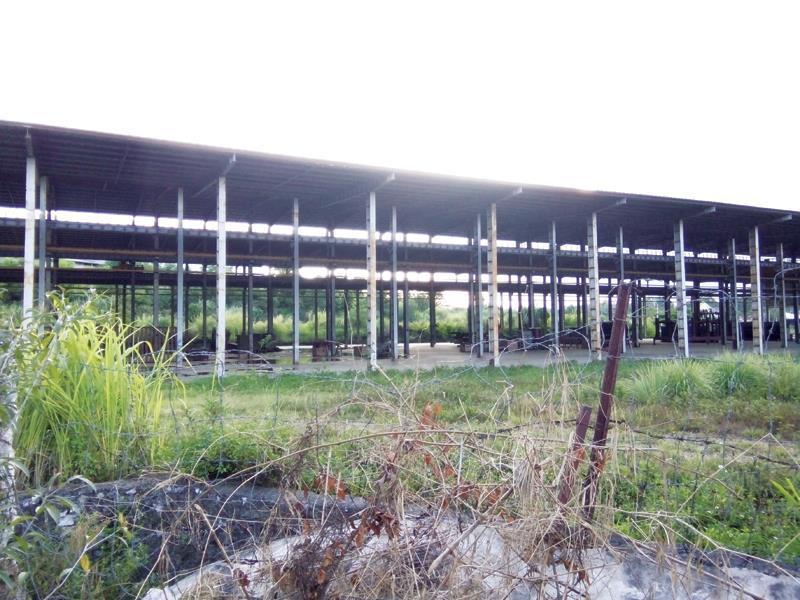Vietcombank is offering for sale Vinaxuki’s workshop, machines and equipment in Hau Loc district in Thanh Hoa province. This is the fourth time the bank has announced the sale of assets to collect long existing debts.

The workshops have been left idle
In early April, Vietcombank put Vinaxuki’s assets on sale at the starting price of VND44.3 billion, but there was no buyer. The starting price was lowered the next time to VND42.9 billion and VND39.5 billion. And now the bank is offering the assets at VND36.3 billion.
In early 2019, Vietcombank sued Vinaxuki Thanh Hoa Automobile Co Ltd in the Hau Loc district’s Court. The bank asked Vinaxuki to implement the repayment of the VND188 billion debt, including the principal of VND98 billion and interest of VND89.7 billion.
Vinaxuki’s president and CEO Bui Ngoc Huyen confirmed the principal of VND98 billion and said Vinaxuki could not pay the debt. Vinaxuki accepted to let Vietcombank foreclose the collateral to collects debt, as the two parties agreed in 2015.
According to Huyen, in 2009, Vinaxuki invested VND200 billion in the automobile factory in the first phase of the project, setting up assembling workshops, bodyshell workshop and component storehouse. The total asset value had reached VND297.227 billion by 2012.
| Huyen believes that if Vinaxuki could have continued to borrow capital in 2013, just VND200 billion, the factory would have resumed operation and it would have paid all the bank debts after three years, because the automobile market at that time began seeing high growth rates. |
In mid-February, BIDV released an announcement about choosing the organization to auction Vinaxuki’s and Xuan Kien Thai Nguyen Automobile Co Ltd’s assets which were collateral for the loans BIDV provided to VInaxuki and the factory in Thai Nguyen province.
As of mid-September 2019, the total principal and interest of the loan had reached VND1.265 trillion. The collateral for the loan included a land plot and assets on the land located in Tien Phong commune of Me Linh district in Hanoi, with the total area of 138,814 square meters. This is where Vinaxuki’s manufacturing factory is located.
The collateral also included the machines and equipment at Vinaxuki Me Linh, the right to exploit antimony ore mine, the ore sorting line in Cu Jut district of Dak Nong province, and the assets on land at Vinaxuki Thai Nguyen factory.
Trillions of dong turn into scrap
In 2004, Vinaxuki built its factory in Me Linh district in Hanoi which had the capacity of 20,000 products a year. In 2006-2008, the factory manufactured more than 20 truck lines with the localization ratio of 27 percent. After three years, the investor was able to take back the investment capital and paid bank debts.
The 2006-2009 period was the golden age of Vinaxuki. The annual lowest profit was VND90 billion, while the highest was VND160 billio.
In 2010, Vinaxuki began making cars with less than nine seats. With the government’s encouragement, Vinaxuki decided to ‘play big’: more than VND900 billion was poured into metallurgy, draft casting, mold production, automatic equipment for the stamping line, plasma cutting, laser cutting, and automatic painting with robots. The manufacturer also set up factories in Thai Nguyen and Thanh Hoa.
During these years, Vinaxuki cooperated with Japanese companies and received technology transfer on car body and tire design, and built a design center. It also joined forces with some companies belonging to the Ministry of National Defence to research and develop armored vehicle with a chassis from Russia.
However, the projects stopped in 2012, when Vinaxuki incurred a loss of VND45 billion and had overdue debts. As the manufacturer had overdue debts, it could not continue to borrow money.
Vinaxuki, which had pioneered the movement of developing Vietnamese automobiles, fell into a tragic situation.
Some investors have shown their intention to buy Vinaxuki’s assets put up for liquidation, but just as scrap. Some others just want to buy the land to develop real estate projects. A large automobile company offered to buy the auto production line at VND670 billion, but the foreign partner did not agree on the price.
Huyen believes that if Vinaxuki could have continued to borrow capital in 2013, just VND200 billion, the factory would have resumed operation and it would have paid all the bank debts after three years, because the automobile market at that time began seeing high growth rates.
However, as the factory was hungry for capital, the production lines have been left idle since then.
According to Huyen, it would be ideal if the mortgaged assets can be sold at a price equal to 20 percent of the original value.
Tran Thuy

Local automobile manufacturers look forward to big preferences
What should automobile manufacturers do – import cars for domestic sale or assemble cars domestically? They prefer the second solution, though the first brings higher profit.

Car prices expected to drop in August
More people could afford imported cars from the EU when the EU-Vietnam Free Trade Agreement (EVFTA) takes effect from August 1.